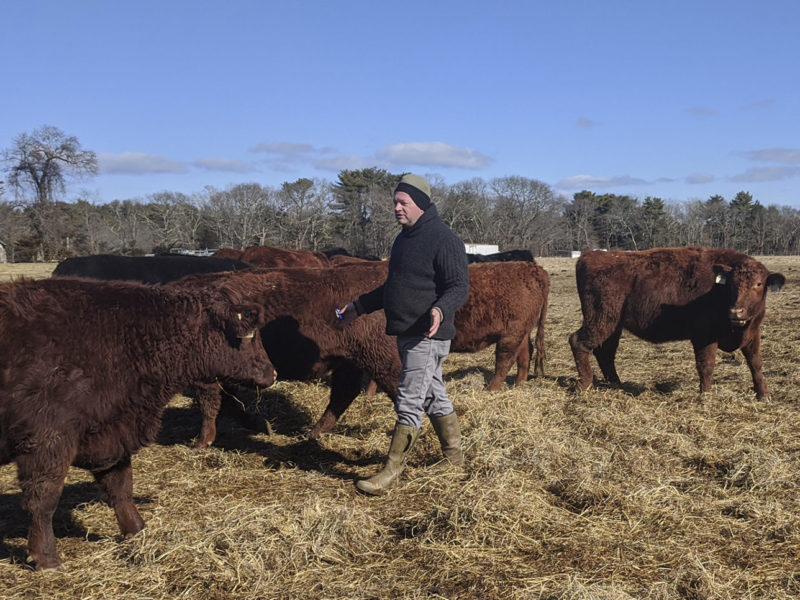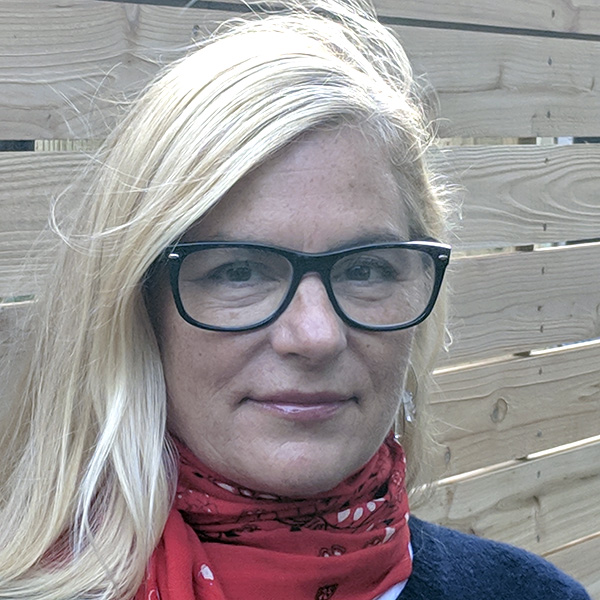

Acabonac Farms owner Stephen Skrenta is happy his cattle are spending their first winter on the East End of Long Island. The cattle seemed very happy too when I visited them in Yaphank on a cold February day.
His current herd of 50 cattle includes shorthorn, black Angus, red Angus, Angus crossed with Hereford, and Devon, all English breeds.
“The ones with white faces are Angus crossed with Hereford. Devon is my favorite breed,” he said, nodding toward one particularly handsome fellow with curly auburn hair. “He’ll probably throw a kick at me.”
Skrenta searches for special animals from Vermont to Tennessee that have smaller frames and wide mouths. “I look at the mom and dad,” he said. “It takes two to tango.”
It also takes a lot of work for a cow producer to get the right genetics. “It’s the secret sauce,” Skrenta said. “If you start with the wrong animal, you’ll never get to the finish line.”
“If it has the right phenotype, or body type, I’ll try to buy it,” said the former Wall Streeter who moved to Amagansett full-time several years ago in order to have a better quality of life for his family.
By keeping his cattle close by, Skrenta has created a year-round source for local pastured beef. The cattle have a better existence and so does the earth on which they graze, creating a better quality of life for all who live here.
The day of my visit, Skrenta and his farmhand, Eric, were weighing the animals, as they do once a month. “If these animals are putting on weight you don’t have issues,” he said. “If they’re sick or picked on, they’re stressed and won’t gain weight.
The weight of the cows tells a lot about their health and this is the most important thing to Skrenta although the health of the soil upon which they graze means just as much, if not more, to him.
The animals help the soil quality by grazing, and they fertilize it by excreting nutrients in their urine and poop. “Mother Nature takes over,” he said. “The cows are tools. The byproduct is beef.”
Previously, Skrenta’s herd spent winters in upstate New York but this year, thanks to the availability of a new on-demand water system borrowed from grazers in New Zealand, the animals are able to drink wherever they are, even on the coldest days in winter.
Having access to water is important for the animal. It puts less stress on the cow and fewer calories are burned. Acabonac cattle gain about a pound a day.
“If we wanted to move cattle here,” he said in the middle of a field. “We can bring water right to them in a cost-effective way.”
That water is delivered through a high-density polyethylene pipe that is run above ground. A simple device is plugged into the waterline, which creates enough space to keep the water flowing. Plan B is a water tank buried five feet underground. Heat from the earth keeps it from freezing.
All of Skrenta’s farm fields are set up exactly the same way with four strands of high tensile wire and certified organic compost wood poles. The electric wire keeps the cattle inside and when the wire is moved, the cattle can be rotated to graze on other parts of the field.
When he first took the 150 acres over in Yaphank, the fields were filled with mugwort, an invasive weed that spreads aggressively through an extensive rhizome system and is native to Europe and eastern Asia. Historically it’s been used as a medicinal herb.
Here, it is hoped the cows will stomp on the weed. They’ll eat it too, though usually they just ignore it. In the winter they’re fed high-quality hay made from orchard grass, imported from the Midwest. Skrenta is talking to farmers about buying hay locally in the near future.
“The beauty of this business model is that the animals do the work,” he said.
Rotating the herd together in one location during the winter also reduces labor. Unlike most of the beef cows in this country, which are fattened on corn diets, this herd is grass-fed. Since his cattle have been grazing the fields, the soil has made a miraculous turnaround to nutrient-dense earth without the use of chemicals or machinery.
Tilling would serve only to disrupt the soil structure. By controlling when and how long the animals are allowed to graze in one area, and planting high sugar grasses such as clover, ryegrass and orchard grass, which out-competes the mugwort and feeds the cattle in spring, summer and fall, Skrenta can accomplish his goals.
In addition to 70 tillable acres, the Yaphank property where the cows are spending the winter includes woodland. Cattle are a woodland animal and the trees help when it comes to shedding their winter coats as they rub against the trunks and low lying branches. The trees also keep the animals cool when it gets too hot.
Come summer, the animals are rotated around all four of the farmer’s East End fields when the herd blooms in size. Skrenta does the math to determine how fast the grass grows per day. He measures the height of the grass in inches and looks at density.
“How much soil do I see looking down,” he asked. “Good grazers will eye density.”
A 1,200-pound animal will eat 2.8 percent of its body weight per day. At the end of the day, Acabonac Farms is averaging a gain of one pound per day — even in winter, which is the hardest time of the year to gain.
“It’s easier in the fall,” said Skrenta. “The weather is conducive to weight gain. We take inventory every day of how much grass we have. We know exactly how much grass to give them.”
Although it’s a giant set of data, figuring out the feed schedule is now a simple part of his routine.
“The worst thing is overgrazing,” he said. “Every year we get better and better.”
Skrenta’s cattle are healthy without the use of antibiotics or growth hormones and you can’t help but notice their shiny coats, without a speck of mud on them, thanks to sandy soil. Mud contains parasites and generally stops the coats from working. These animals have eyes that are clear and hooves that are clean. As long as they don’t step in a gopher hole and break a leg, all is as it should be.
“As policy, we don’t promote death on this farm,” he said. “That may sound crazy.”
Many farmers thought Skrenta was crazy when he took over the Yaphank field. He believes his neighbors, who use synthetic fertilizers, and were skeptical of his all-natural techniques, will come around now that they can see the improvements in the land in such a short amount of time.
“Our practices are better than organic as a whole,” he said.
When it comes to acquiring land for pastures, Skrenta has proven that his herd can turn around a formerly conventionally farmed field. Another neighbor to the grazing cows is a golf course, which comes with its own set of challenges. One being a pool of standing water in the back field but again, with the regeneration of the soil, the problem is close to being completely resolved. The cows ignore the golf balls. As we walk the fields the farmer picks them up and tosses them along the fence.
In typical feedlots, where cattle are fed government-subsidized corn, the smell will knock you to your knees. But in Yaphank, there’s no smell even when standing over a cow patty, which Skrenta does quite a bit. Monitoring manure is another way to ensure weight gain.
“This manure pile is pretty good,” he said. “Not too dry.”
Another pile of poop is a little drier. “Still pretty good, not great,” he said. “See this swirl? When moisture pools up here in the middle, we hit the lottery.”
Just as there is a “no death policy,” there is also a “no stress policy” on the farm. If the animals are stressed, the one-pound gain goes away. So when it comes time to move the herd, they are gently guided into the metal corral where they step on a platform one by one.
No yelling, no shock.
“We don’t even own a prod,” he said. “We don’t put them in a head gate to weigh them.”
Skrenta says that Suffolk County has been unbelievably supportive toward his business model, even holding a farmers event in Yaphank last fall.
“I think from their perspective they see a lot of value in this which makes me feel very good,” he said.
“It’s healthy stuff and good for the environment. You can even argue it’s good for the animals,” he said, adding, “I understand there’s a bad day at the end.”
When the bad day comes, Skrenta can eye the distance between the bottom of the animal to the ground, noting it’s ready to go. Currently, the animals are processed in Connecticut and Pennsylvania at USDA facilities.
A feasibility study is in the works to determine the viability of Skrenta acquiring a county-owned facility in Yaphank which would bring the process home.
“After the beef is slaughtered it is dry aged for three weeks and then it is butchered,” he said. Then it’s flash frozen to lock in freshness and shipped from frozen storage in Farmingdale and Middle Island.
While modern agriculture wants everything right away. The real deal takes a little longer.
“As quick as Mother Nature intends,” he said. “Working against Mother Nature, you’re not going to win.”
 More Posts from Kelly Ann Smith
More Posts from Kelly Ann Smith